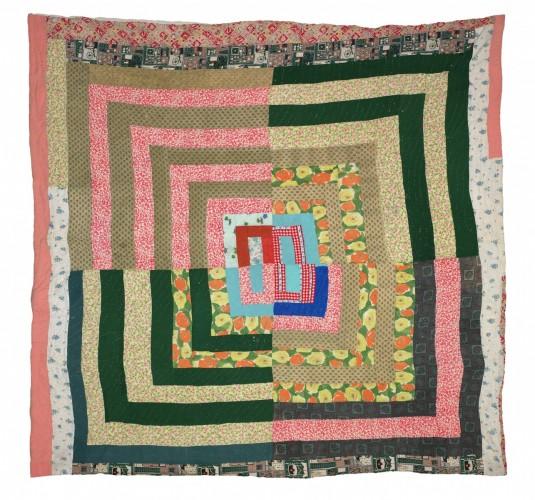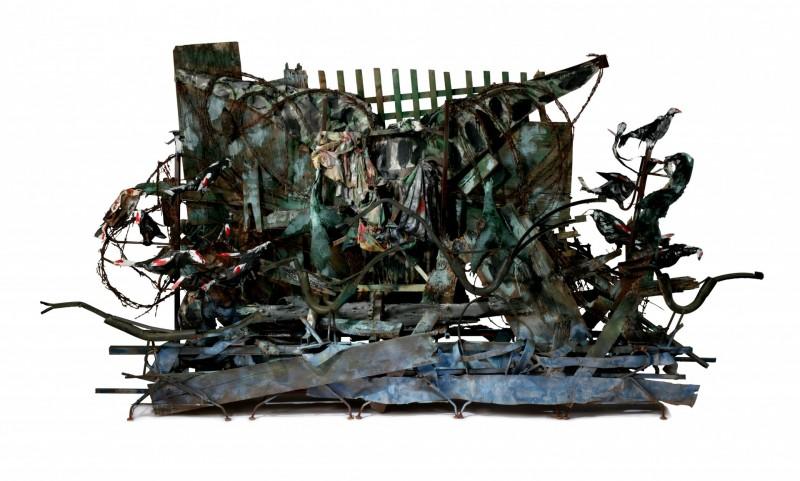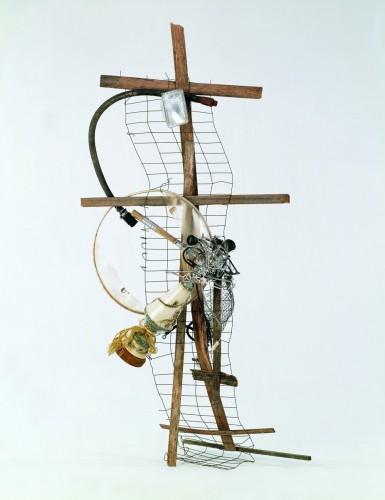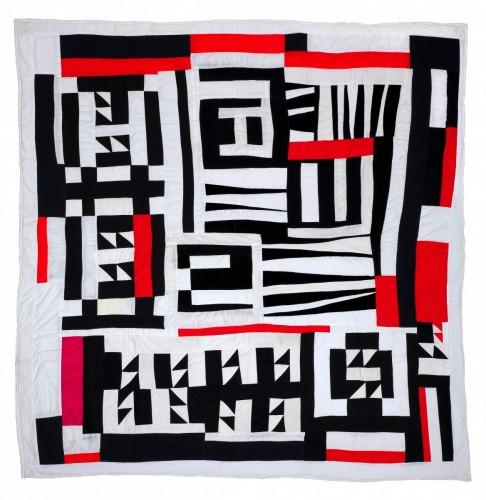Another highlight is Housetop by Delia Bennett (1892-1976), who was the matriarch of an extended family of quiltmakers that included daughters and granddaughters. This quilt, made about 1955, is a “fractured” variation of the traditional single-block design. It uses four separate L shaped Half-Log Cabin blocks stitched together to make a larger Housetop pattern.
Other quilters represented in the Souls Grown Deep acquisition are Nellie May Abrams (1946-2005); Annie E. Pettway (1904-1971); Henrietta Pettway (1894-1971); Loretta Pettway (b. 1942); Martha Jane Pettway (1898-2003); Sue Willie Seltzer (1921-2010); Andrea P. Willliams (b. 1973); Irene Williams (1920-2015); Magdalene Wilson (1898-2001); and Nettie Young (1916-2010).
Ann Percy, the Museum’s Mainwaring Curator of Drawings, stated: “For more than 20 years, the Philadelphia Museum of Art has been committed to collecting works by self-taught artists and to presenting their achievements in the context of an encyclopedic museum. In several shows mounted from our holdings we have emphasized interfaces between work by artists who operate outside the ‘establishment’ and those that are part of the mainstream, as they often share basic approaches and strategies. Thanks to the vision of William C. Arnett, who formed the Souls Grown Deep collection through decades of acquiring and championing the work of African American artists from the southeastern United States, the Foundation now holds an unequalled body of work by these artists. With the current acquisition, the Philadelphia Museum can better represent this important and distinctive component of the history of American art in its collection.”
About Souls Grown Deep
The Souls Grown Deep Foundation was founded in 2010, but traces its roots to the mid-1980s, when Arnett, an art historian, scholar, and patron, began to collect the work of previously undiscovered African American artists across nine southeastern states. Most of the works and ephemeral documents held by the Foundation were compiled by Arnett and his sons over three decades, with the goal of creating a collection that could serve as a record and legacy of this culture. By the mid-1990s Arnett’s efforts grew to become an ambitious project to survey the visual tradition of the African American South. It resulted in a remarkable two-volume book, titled Souls Grown Deep: African American Vernacular Art of the South, published in 2000-01, which remains the most in-depth scholarly examination of its kind.
This acquisition at the Philadelphia Museum of Art is one of several in the Souls Grown Deep Foundation’s ongoing gift/purchase program, following major acquisitions by museums including the High Museum of Art in Atlanta, the Fine Arts Museums of San Francisco, and the New Orleans Museum of Art earlier this year, as well as a gift to the Metropolitan Museum of Art in New York in 2014. The Foundation is the only non-profit organization dedicated to documenting, preserving, exhibiting, and promoting the work of contemporary African American artists from the American South. It holds the largest and foremost collection of works of contemporary African American artists from the Southern United States, encompassing over 1,200 works by more than 160 artists, as well as a collection of archival photographs, videos, and documents relating to the artists in the collection. The Foundation’s gift/purchase program is designed to strengthen the presentation of African American artists from the Southern United States in the permanent collections of leading museums across the country.
African American Art at the Museum
The Philadelphia Museum’s commitment to collecting and promoting African American artists stretches back to the early development of the institution in the late nineteenth century. The Museum has rich holdings of works by African American artists embodying many different mediums and styles, from the ceramics of enslaved potter David Drake and the Paris salon paintings of Henry Ossawa Tanner, to untrained painter Horace Pippin’s depictions of twentieth-century African American life and works by celebrated contemporary artists Martin Puryear and Kara Walker. This longstanding tradition was recently celebrated in the 2015 exhibition and comprehensive publication Represent: 200 Years of African American Art in the Philadelphia Museum of Art.
Works by self-taught artists at the Philadelphia Museum of Art
Over the past two decades, the Philadelphia Museum of Art has acquired close to 600 works by self-taught artists, including figures such as James Castle, William Edmondson, William Hawkins, Martín Ramírez, and Bill Traylor. This has contributed to establishing the Museum as one of the nation’s important centers for research and programming in the field, while also drawing attention to the works produced by minorities and others who are often underrepresented in the art world. The Museum has organized or presented four important exhibitions in this field: Self-Taught Artists of the Twentieth century: An American Anthology, 1998; Gee’s Bend: The Architecture of the Quilt, 2008; James Castle: A Retrospective, 2008; and “Great and Mighty Things”: Art from the Jill and Sheldon Bonovitz Collection, 2013, which celebrated the promised gift of a major private collection. Smaller shows from the Museum’s collections have included The Art of the House: Drawings and Prints from the Artist Community at Gugging, 1995, and When Reason Dreams: Drawings Inspired by the Visionary, the Fantastic, and the Unreal, 2000. The Museum’s celebrated holdings of modern art, including the A. E. Gallatin and the Louise and Walter Arensberg collections that form the foundation of our twentieth-century holdings, and our important – and expanding – collection of contemporary art can be enriched in significant ways by being presented in conjunction with works such as those that form the collection of the Souls Grown Deep Foundation.




























